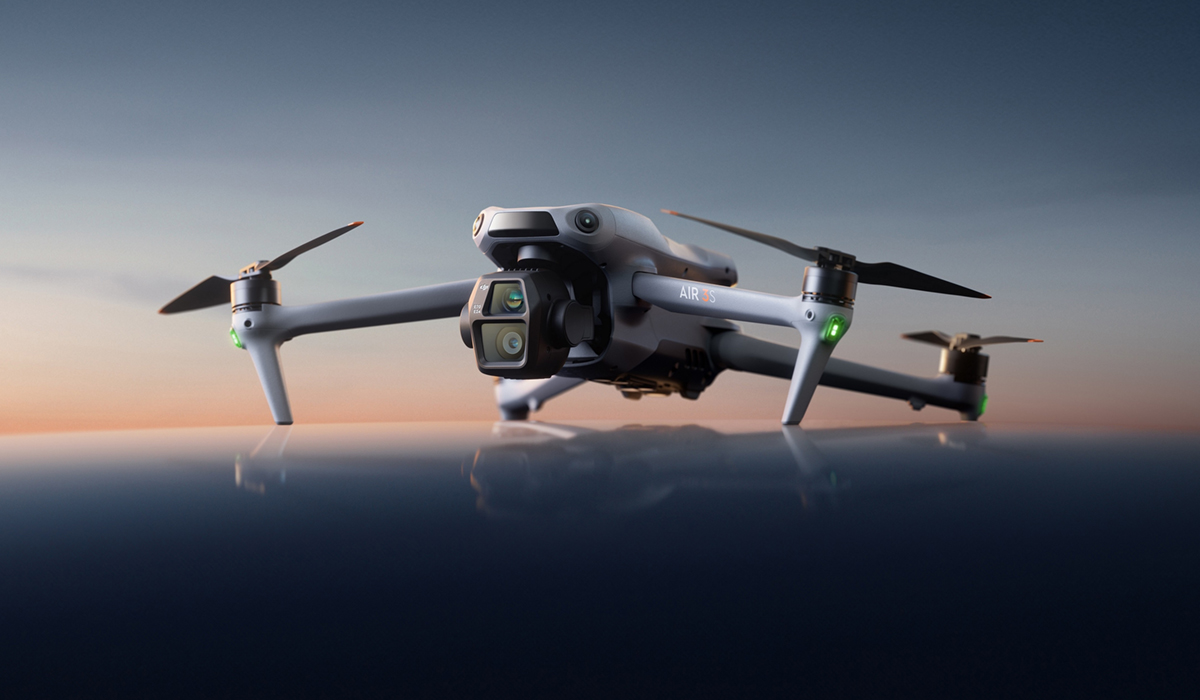DJI will bring another drone to its expanding lineup with the Air 3S, an upgrade over its predecessor led by a larger image sensor. It’s not an overhaul of the previous design since DJI largely sticks to the same body but makes some changes underneath to improve image quality.
That means it’s still a dual-camera setup with wide and telephoto lenses, though DJI claims the Air 3S can capture better photos and video than the Mavic 3 Pro. The company clearly has content creators and travellers in mind based on key specs. Especially when you also consider the improved obstacle avoidance.

What you get with the DJI Air 3S
The biggest change lies with the 50-megapixel 1-inch CMOS sensor in the primary wide camera. A larger sensor can gather more light, and this one can capture up to 14 stops of dynamic range. That should result in more detailed photos in more varying conditions. You can record video in 4K at 60fps or 120fps, including in 10-bit D-Log M colour mode.
DJI says the new sensor can also capture better images in low-light settings (think sunsets and nightscapes) because of improved image processing. The company also boosted the video encoding compression algorithm to reduce video file sizes by over 30% without sacrificing image quality. With 42GB of available storage space, there may be a little more room to save content.
All that goes for the 48-megapixel telephoto camera with 3x optical zoom as well. It’s the same image sensor previously equipped in the DJI Air 3 yet benefits from the same video specs and colour modes as the primary camera.
Both cameras also make use of the newer Free Panorama mode that stitches together panoramic shots when you manually select a subject or area. It does this by combining the field of view (FOV) from the main camera with the detail captured by the telephoto camera. That’s also where 14 stops of dynamic range can make a difference in output. It also applies to both stills images and video footage.
New obstacle sensing
The DJI Air 3S will be the first of the company’s drones to offer forward-facing LiDAR to improve its ability to recognize obstacles faster and from further away in order to avoid them. That will work in tandem with the infrared time-of-flight (TOF) sensors and vision sensors at the front, rear and bottom (six total) to help the drone sense obstacles in low-light and night conditions.
The drone also has ActiveTrack 360 to stick with a subject and keep them in the frame. This time, it includes a new Subject Focusing feature that keeps a subject in focus while moving out of the centre of the frame. The idea is to get more creative in framing a shot that doesn’t necessarily require the subject to be right in the middle. What’s also neat is how the Air 3S memorizes flight paths to help it return safely when you release it in areas without a satellite signal. Other tracking modes like Rocket, Dronie, Circle, Helix, and Boomerang are also available, along with standard ones like Selfie, Orbit, and Auto-Follow.
What you get with the standard kit
The standard kit gets you the DJI Air 3S drone, along with the RC-N3 Controller, one battery, one gimbal protector, and one set of replacement propellors. You can always purchase any other accessories compatible with the drone later on if you don’t want to go with a bigger kit.
DJI Air 3S Fly More Combo
The Fly More Combo pack includes everything you get with the standard kit along with extra accessories. Rather than the RC-N3 controller, you get the RC 2 Controller and its built-in 5.5-inch screen. There are two extra batteries for three total, including a charging pack for all of them, plus the ND Filter Set and a bag to carry everything.
The DJI Air 3S is available today at Best Buy
The DJI Air 3S retains the same 45-minute max flying time. If you want to take it to the air, it’s available today at Best Buy as standalone drone or the Fly More Combo pack. For more information on DJI and other drones, check out the latest ones available now.


